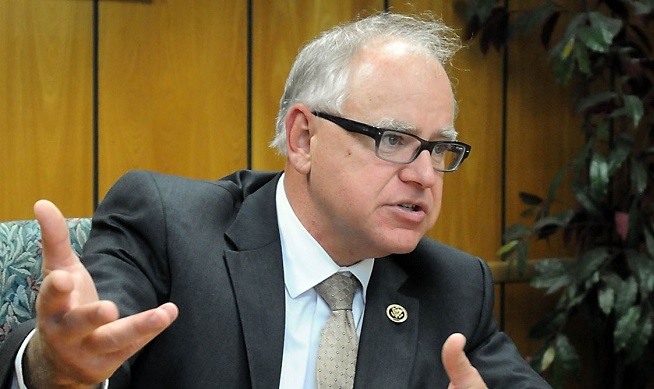Many people are asking: Did Minnesota lawmakers and Gov. Tim Walz repeal the right to lifesaving care for born-alive infants? Is it really true that babies can be left to die?
Some journalists, advocates, and politicians have gotten this question wrong—often badly wrong. Let’s walk through the facts, one by one, with documentation and screenshots, and respond to frequently asked questions and confusions.
The truth about this matter is something that everyone can see and verify for themselves.
Minnesota’s previous protection
Minnesota’s longstanding and bipartisan Born Alive Infants Protection Act (MN Statutes 145.423) was first enacted in 1976 and updated in 2015, when it was signed into law by Democratic Gov. Mark Dayton. It protected babies who survive abortion procedures and are born alive. Among other things, the law required that “reasonable measures consistent with good medical practice” be taken “to preserve the life and health of the born alive infant.”
This policy didn’t require futile or extraordinary measures for newborns with a terminal condition, but it did mean that viable babies can’t just be set aside and left to die. Abortion survivors must receive medically appropriate care that would save their lives—just like any other baby born at the same gestational age.
LifeNews is on TruthSocial. Please follow us here.
Look for yourself: Here’s the 2015-passed version of Minnesota’s Born Alive Infants Protection Act.
What Walz and the legislature did
In 2023, a narrow DFL-only majority in the legislature passed—and Gov. Walz signed—an omnibus bill (SF 2995) that repealed or amended numerous laws relating to abortion, including the Born Alive Infants Protection Act.
Among the changes: No longer must reasonable measures be taken “to preserve the life and health of the born alive infant.” Instead, measures must be taken only to “care for the infant who is born alive.” This was repeatedly described by the bill’s House author, Rep. Tina Liebling, as “comfort” care, as opposed to lifesaving care (see the discussion beginning at 1:45:54).
In addition, part of the subdivision’s heading was changed from “medical care” to just “care.” And the law’s language was altered to no longer apply specifically to babies who survive abortion, but rather to all babies who are born alive.
The new version also eliminates the civil penalties for violating the law (see subd. 5 of the old law), and it repeals the previous requirement that cases of born-alive infants—and the measures taken or not taken to care for them—be reported to the Minnesota Department of Health (MDH).

Look for yourself: Here are some of the key changes made by SF 2995 to the Born Alive Infants Protection Act.
What the changes mean
Whereas Minnesota’s previous law guaranteed medically appropriate care that would save infants’ lives, the new law does not. It requires only comfort care (i.e., care that keeps patients temporarily comfortable but does not try to save their lives). Indeed, future courts will likely look at the legislative intent—the bill’s author described the new requirement as “comfort” care, rather than lifesaving care—when understanding what the law means. This was a very deliberate and specific change that lawmakers went out of their way to enact.
Under the new language, then, viable babies can be set aside, with only comfort care, and allowed to die. This policy is a threat to “unwanted” babies born in the context of abortion, but it also endangers other infants, especially those born with disabilities, whose lives are often devalued.
It’s true that the law retains previous language affirming that born-alive infants are human persons who deserve protection. But recognizing personhood is not the same as requiring any particular standard of care (indeed, other patients, such as elderly and disabled persons, are sometimes denied care even though they are recognized as persons under the law). Moreover, the new version of Minnesota’s policy removes the penalties for violating it, undermining any effective enforcement.
And it gets worse: The public will no longer even know about born-alive infants because Walz and the legislature repealed the reporting requirement. Minnesotans will be kept in the dark.
Who voted for it? Here’s how Minnesota lawmakers voted.
What do the new law’s defenders say?
Lawmakers and advocates who support the changes—and journalists who repeat their claims—have usually defended them this way: The previous law, they say, mandated extraordinary and burdensome measures to try to prolong life even when those measures were futile. They say that such a mandate was not compassionate for grieving families whose babies would soon die.
For example, according to a purported fact check in the Minnesota Star Tribune, the old law required that “an infant with severe anomalies undergo extraordinary and futile medical care.” Without such a requirement, “parents in Minnesota can now hold their dying infant to say goodbye if that is what they have chosen.” MPR News and other media outlets have repeated the same claim without any questioning or due diligence.
The problem with it is that Minnesota’s previous law plain
And that—preventing babies from being left to die—is precisely what Walz and the legislature decided to reverse.

Reports from the health department confirm that practitioners of abortion never thought Minnesota’s previous law required extraordinary measures. In 2015, for example, after the updated version of the Born Alive Infants Protection Act was enacted, MDH noted that some infants “were reported to have lethal fetal anomalies incompatible with life and thus no measures were taken to preserve the life of these infants” (emphasis added).
Do babies really survive abortion?
Yes. In most years since reporting began in 2015, between three and five born-alive abortion survivors have been reported to the Minnesota Department of Health. Nationwide, the Centers for Disease Control (CDC) has reported that, between 2003 and 2014, at least 143 babies were born alive after abortion (the actual number, the CDC acknowledges, may be higher). Hundreds of abortion survivors who have lived are now part of the Abortion Survivors Network.
Research in the medical journal Obstetrics & Gynecology found that, without a lethal injection to first kill the child, abortions on babies with abnormalities performed between 20 and 24 weeks’ gestation led to live births in about half of cases.
Watch: Learn about survivors of abortion and their stories.
But don’t all of these babies have terminal conditions?
According to a fact check by KARE 11, “Any abortion performed that late in pregnancy would involve an infant that wouldn’t be able to live very long after birth.”
That’s not true. Some later abortions do involve a fatal prenatal diagnosis, but many others do not. “Data suggest that most women seeking later terminations are not doing so for reasons of fetal anomaly or life endangerment,” explains a study by pro-choice researchers published in Perspectives on Sexual and Reproductive Health. Warren Hern, a well-known practitioner of late abortion in Colorado who performs elective abortions even beyond 30 weeks, told The Atlantic that at least half of his abortions are not because of adverse prenatal diagnoses.
Moreover, Minnesota’s new policy applies to all born-alive infants, not just ones who survive abortion. So other infants are at risk too.
Look for yourself: Review a collection of studies and other evidence on abortions late in pregnancy.
No one would actually deny lifesaving care, right? Isn’t the old law unnecessary?
“You don’t need that born-alive law to protect infants against infanticide,” Rep. Liebling, the House author, claimed during debate over the bill to amend the law. But is that true?
Reports from the Minnesota Department of Health at least suggest that—even under the previous law—born-alive abortion survivors have not, in some cases, received measures that could have saved their lives. While some reported cases describe the infant as “previable” or as having a fatal condition, others make no mention of such factors or of any measures to protect life.

Moreover, evidence from many other places demonstrates that infants who survive abortion have often been neglected or even actively killed. This evidence includes the eyewitness testimonies of doctors, nurses, and mothers; infamous cases like that of Kermit Gosnell; undercover investigations; and more. (Such evidence should not be too surprising: These are babies who were intended to die and who likely have no advocate in the room after they are born.)
Above are screenshots from the 2016 and 2017 abortion reports released by the Minnesota Department of Health.
Babies born with disabilities or the risk of disabilities (and not just those born in the context of abortion) are also too often endangered. An analysis in the Journal of Perinatology, for example, notes strong evidence showing that “when a newborn is at risk for a certain level of disability, some [health care providers] will deem it acceptable to withhold or withdraw life-sustaining therapy and allow him to die, whereas an older child with that level of disability may not be considered a candidate for comfort care [rather than lifesaving interventions].” To explain the unequal treatment, the researchers write that “it is possible that neonates, and possibly the very premature infant, are not considered [by some health care providers] to be the same kind of persons as older children” (emphasis added).
Minnesota’s current law enables this lethal discrimination and ableism. Because of Walz and the Minnesota legislature, babies in our state who are born after abortion or who have disabilities can be denied appropriate lifesaving medical treatment—and left to die.
Look for yourself: Here are the annual abortion reports from the Minnesota Department of Health.
Learn more
Below are additional resources about Gov. Walz and Minnesota’s policies surrounding abortion and born-alive infants:
- Minnesota’s extreme abortion policy
- Tim Walz’s extreme record
- Watch: An interview with MCCL’s Cathy Blaeser about Tim Walz’s record on life
- Letter to the editor: Correcting a misleading media fact check on Minnesota’s policies
- Who are they leaving out, and why? Here’s how Minnesota lawmakers are excluding vulnerable members of the human family.








